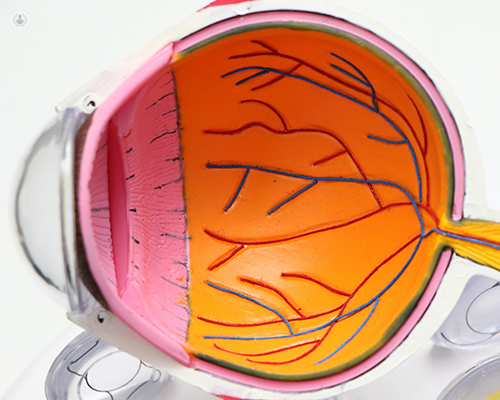Surgical retina: Essential information on surgery, recovery, and eye health
Escrito por:Surgical retina is a specialised branch of ophthalmology focused on treating conditions that affect the retina, the light-sensitive tissue layer at the back of the eye essential for clear vision.
This article explores when retina surgery is required, the different surgical options, and the long-term outlook for vision and retina health after surgery.

When is retina surgery necessary?
Retina surgery is required when a retinal condition poses a significant risk to vision and can’t be treated effectively with non-surgical approaches. The retina is a thin, sensitive layer of cells at the back of the eye that captures light and sends visual information to the brain. When the retina is damaged, vision is significantly affected.
Several retinal conditions may require retina surgery, including:
Retinal detachment
Retinal detachment is a sight-threatening condition where the retina peels away from the back of the eye, leading to permanent vision loss if not promptly treated. Symptoms may include a sudden increase in floaters, flashes of light, or a shadow in the peripheral vision. Surgery is required to reattach the retina and restore vision.
Macular hole
A macular hole is a small hole in the macula, the central part of the retina responsible for sharp vision. Macular holes can distort vision, impair reading and other detailed tasks, and lead to progressive vision loss. Surgery is required to close the gap and improve vision.
Epiretinal membrane
Epiretinal membrane is a thin layer of scar tissue that forms on the macula’s surface, causing blurred or distorted vision. Surgical removal of the tissue can improve vision clarity.
Diabetic retinopathy
Diabetic retinopathy is a diabetes complication that causes damage to the blood vessels in the retina. In advanced stages, abnormal blood vessels can cause bleeding or scar tissue that pulls on the retina. Surgery is needed to stop bleeding, remove scar tissue, and repair retinal damage.
Each of these conditions can progressively damage vision. Surgical treatment is the only option to prevent further deterioration.
What are the different surgical options for these retinal conditions?
There are several types of retina surgery, each with specific indications and potential outcomes. Your ophthalmologist will recommend the procedure that best suits your needs.
Vitrectomy
Vitrectomy is the most frequently-performed retina surgery and involves removing the vitreous gel from the eye to access the retina directly. By removing the vitreous, your ophthalmologist can work on the retina and remove scar tissue, repair retinal tears, or apply laser to seal problematic blood vessels. It is used for several retinal conditions, including retinal detachment, macular holes, diabetic retinopathy, and vitreous haemorrhages.
Laser photocoagulation
Laser photocoagulation uses a laser to seal or destroy abnormal blood vessels or to bond the retina to the underlying tissue. The laser helps to prevent further damage to the retina by reducing blood vessel leakage or sealing small tears. It is used for conditions such diabetic retinopathy to prevent bleeding and protect against retinal detachment.
Scleral buckling
During scleral buckling, a small silicone band is placed around the outside of the eye to gently press the sclera against the retina. This technique relieves the pull on the retina, helping it reattach to the underlying tissue in cases of retinal detachment.
Pneumatic retinopexy
Pneumatic retinopexy is a minimally invasive procedure that involves injecting a small gas bubble into the eye. The bubble then gently presses the detached retina against the wall of the eye, helping it reattach naturally over time. It is often used for smaller retinal detachments.
What can I expect during the recovery period after surgery?
Immediately after surgery, you may experience blurred vision, mild discomfort, and sensitivity to light. Pain is generally manageable with prescribed medications. In some cases, your ophthalmologist will provide eye drops to prevent infection and manage inflammation.
You will need to avoid heavy lifting, bending over, intense exercise, and other activities like swimming that could pressure on the eye or expose it to infection. Driving may also be restricted until vision stabilises. If a gas bubble was used, air travel is prohibited until the bubble naturally dissolves, as changes in altitude can cause complications.
For some types of retina surgery, such as pneumatic retinopexy, you will be required to maintain a specific head position, often face-down, for several days to ensure the gas bubble stays in place and helps the retina heal.
Generally, recovery can take several weeks to months, and it’s essential to follow all post-operative instructions. Most patients can expect follow-up visits within a day or two post-surgery, followed by additional visits over the next few weeks or months.
What is the long-term outlook for my vision and retina health after surgery?
Retina surgery can be very effective in stabilising or improving vision, but it doesn’t guarantee a full return to pre-condition visual acuity, especially if the retina had been severely damaged before surgery.
Following retina surgery, regular eye examinations are critical. Most ophthalmologists will recommend an eye exam every six months to a year after retina surgery, though the frequency may be adjusted based on your individual needs. Early detection of any recurring or new issues is essential to maintaining long-term eye health.


